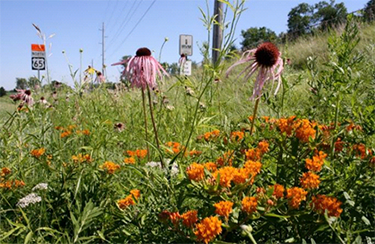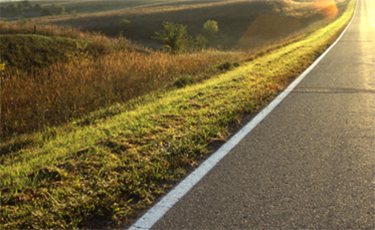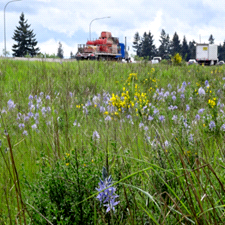Roadside Revegetation: An Integrated Approach to Establishing Native Plants and Pollinator Habitat
Chapter 8 – Case Studies
Table of Contents
Chapter 8 provides five case studies to highlight successful pollinator-friendly practices and strategies in various roadside projects from multiple parts of the country. Several of these case studies are a subset of those found in Hopwood et al 2016a.
8.1 I-35 CORRIDOR (AKA “THE MONARCH HIGHWAY”) CASE STUDIES
The 2015 “National Strategy to Promote the Health of Honey Bees and Other Pollinators” is a strategy calling for, among other things, a multi-state partnership called the “Monarch Highway” along the I-35 corridor. Running through Minnesota, Iowa, Missouri, Kansas, Oklahoma, and Texas, the I-35 highway spans the central flyway monarch butterflies take during their annual migration. The “Monarch Highway” effort hopes to serve as a national model of cooperation to enhance pollinator habitat along transportation rights-of-way. The six states involved in the strategy have agreed to coordinate efforts to establish best practices and promote monarch butterfly and pollinator conservation. A list of I-35 plant species and their pollinator attributes is available in the Native Revegetation Resource Library.
8.1.1 BRINGING PRAIRIE BACK TO IOWA: IOWA’S INTEGRATED ROADSIDE VEGETATION MANAGEMENT PROGRAM AND LIVING ROADWAY TRUST FUND
The two following case studies highlight successful projects from Iowa, one of the six states that comprise the I-35 corridor where agencies are focused on restoring habitat to support the imperiled Monarch butterfly and other pollinators.

Butterfly milkweed and prairie cone flower flourish along an Iowa roadside.
Photo credit: Iowa Living Roadway Trust Fund
 Photo credit: Carl Kurtz
Photo credit: Carl Kurtz
Prairie once dominated Iowa’s landscape, covering more than 85 percent of the state. With less than 0.1 percent of virgin prairie remaining, and more than 95 percent of Iowa’s original wetlands destroyed, Iowa had the nation’s most altered landscape as of the 1980s. Prior to the mid-1980s, roadside weed control in Iowa relied heavily on blanket spraying, putting large amounts of herbicide into the environment with undesirable consequences. Recognizing Iowa’s lost heritage and the need to protect groundwater and surface waters, Iowa roadside managers began making some changes. For example, they began using native prairie grasses and wildflowers for erosion control and reintroduced “a little wildness,” according to Kirk Henderson, retired State IRVM Specialist from the Native Roadside Vegetation Center at the University of Northern Iowa.
In 1989, the Iowa legislature passed IRVM legislation to promote an integrated approach to roadside management while maintaining a safe travel environment (Code of Iowa, Chapter 314). Section 314.21 created the Living Roadway Trust Fund to develop and implement IRVM plans. Section 314.22, titled “Integrated roadside vegetation management” established goals and responsibilities for the State DOT that other roadside managing agencies could adopt. Iowa
is widely seen as a leader in IRVM, in large part because of this legislation. The Living Roadway Trust Fund includes an annual competitive grant program that the Iowa DOT administers to provide funding for school, city, county, and state projects, as well as research projects involving IRVM.
Iowa’s road use tax, along with several other sources, funds the Living Roadway Trust Fund. Roadside managers can submit applications to obtain resources to help implement IRVM, including vegetation inventories, purchasing native seed, equipment for burns or plant establishment, GPS units, signage, workshops, and more. Roadsides are seeded with mixes of species that are appropriate for a particular site, including many native wildflowers that are attractive to pollinators. Seed mixes also contain species that bloom at different times throughout the growing season, which helps support pollinators all season long. The targeted vegetation management practiced by Iowa’s roadside managers also benefits pollinators (Ries et al 2001).
8.1.2 IOWA’S NATURAL SELECTIONS PROGRAM INCREASES IOWA NATIVE SEED
Research projects have also been supported by the Living Roadway Trust Fund, including studies of restoration techniques, as well as studies of the impact of roadside habitat on butterflies (Ries et al 2001) and bees (Hopwood et al 2010). Since the 1989 law was passed, more than 100,000 acres of Iowa’s nearly 600,000 acres of state and county roadsides have been planted to native vegetation (Brandt et al 2015). In the process, Iowa has fostered the development of experienced roadside managers who are equipped to collaborate with other land managers around the state and bring habitat and wildlife, such as pollinators, back to Iowa’s landscape.
The Natural Selections program was formed to build the native seed industry in Iowa to meet the demands for high quality, regionally adapted, and genetically diverse sources of native seed for prairie restorations, including roadside restorations. For native regional seed to be priced to compete with cultivars, it has to be produced in commercial quantities. The Natural Selections program is a collaboration between state and federal agencies, as well as private corporations. Past or present partners include the Iowa Crop Improvement Association, the Living Roadway Trust Fund administered by Iowa DOT, USDA Natural Resources Conservation Service Elsberry Plant Materials Center, the University of Northern Iowa, and independent seed producers. Seed is collected by hand from remnant populations by the project manager and by volunteers throughout the state. Seed is collected from remnant roadsides, natural areas, and private land in three regional zones within Iowa. Iowa’s Natural Selections program uses provenance zones large enough to support a market but narrow enough to retain regional distinctiveness. Collectors do not collect seed to intentionally select for certain traits. Foundation seed plots at the University of Northern Iowa amplify the seed, which is then further increased. Once seed has been increased, it is released to qualified native seed growers with production certified by the Iowa Crop Improvement Association. About 6 to 8 years after the initial collection, enough seed is available to sell to the public.
Successes of the project include increasing seed of 70 species, with nearly 120 ecotypes of 60 species released for commercial production and 180,000 to 200,000 pounds of ecotype source-identified seed produced annually. More information can be found at the Tallgrass Prairie website.
Back to top
8.2 FLORIDA RESOLVES TO PROTECT WILDFLOWERS ON
ROADSIDES
The following case study from Florida highlights a unique citizen-based effort to protect pollinator habitat through county policy resolutions that were subsequently supported by pollinator-friendly management plans.
Florida, home to a great diversity of plants and animals, was once dubbed the “land of flowers” by a Spanish explorer in 1513. Many of these wildflowers can be found on Florida’s 200,000 acres of roadsides. However, wildflower proliferation along roadsides can be limited by the frequency of mowing. Roadside mowing can be very intensive in some parts of Florida, particularly in urban areas. When showy stands of wildflowers were mowed during bloom when pollinators were present, concerned citizens contacted Florida DOT. Jeff Caster, State Transportation Landscape Architect with Florida DOT, describes the situation: “There would be butterflies on the side of the road feasting on the native vegetation and we would come in and mow it all down and we would get people naturally upset with us. Environmentally conscious citizens called us to complain that we were mowing down wildflowers and butterfly habitat.”
Florida DOT is not able to alter management plans based on direct requests from a garden club or an individual that wants less roadside mowing. But citizens in Wakulla County found another way. They worked with their county commissioners to draft a resolution that made it county policy to preserve existing stands of roadside wildflowers. Then, county staff worked with Florida DOT to develop a roadside management plan to accommodate the resolution.
Recognizing the cultural, historical, and environmental significance of native wildflowers, 27 out of Florida’s 67 counties have moved to adopt similar wildflower resolutions. These counties “make a commitment to saying they want to enjoy the visibility of wildflowers for whatever reason, some do it to attract nature-based tourism, some doing it to help their farms,” Caster says. A model resolution can be found on the Florida Wildflower Foundation’s website.
Florida’s unique grassroots approach to protecting wildflowers at the county level has great potential for pollinator conservation.
Back to top
8.3 MAPPING AND PLANNING BENEFIT WASHINGTON STATE POLLINATORS
Washington State DOT (WSDOT) maintains about 100,000 acres of roadside. WSDOT has been implementing integrated vegetation management for many years with the overarching goal of reducing undesirable vegetation while encouraging desirable vegetation. Many of their practices and policies to manage vegetation also promote pollinator habitat.
Whenever possible, WSDOT preserves existing native habitat that can provide food, host plants, shelter, and nesting for pollinators. WSDOT also identifies roadsides for “managed succession” (WSDOT 2003). These are areas that have desirable vegetation that could flourish under a strategy that allows natural plant succession to proceed to a stable plant community.

A site identified through GIS analysis as a priority location for managed succession to replace nonnative species with desirable native species. Careful planning and management for a number of years has increased native plants such as camas, snowberry, serviceberry, and Oregon grape, but invasive scotch broom still remains and requires selective treatment with herbicides.
Photo: Washington State Department of Transportation
Outside of the clear zone or lines of sight where repeated mowing still occurs, roadsides managed for natural succession have multi-year treatment strategies that employ a variety of vegetation management tools, including reduced mowing and targeted herbicide use. Managed succession allows native vegetation to emerge and flourish, with sagebrush (Artemisia tridentata), greasewood (Sarcobatus vermiculatus), and native grasses taking hold in prairie regions, and understory shrubs that are attractive to pollinators like snowberry (Symphoricarpos albus), Oregon grape (Mahonia nervosa), and spirea (Spiraea sp) in other regions.
When roadside revegetation is needed, WSDOT prioritizes the use of native plants, including a diversity of native wildflowers and flowering shrubs and trees. Landscape designers focus on native plants that can establish with minimal input and compete with weeds. Key considerations for pollinators during the planning process include sequential bloom periods of flowering plants and high plant diversity. Maintenance staff are included in the planning process to provide input on long-lived plants that can be managed minimally.
Mapping and planning are key elements of Washington DOT’s approach to roadside revegetation and maintenance. Vegetation inventories help to identify areas with weed infestations as well as areas that are conducive to managed succession. All maintenance staff have tablets, used to record data and view maps and aerial images.
WSDOT uses the best available science to inform its actions and also undertake its own research to determine the right methods for their management needs. For example, experimental plots are used for testing seed mixes and planting methods. WSDOT also monitors the effectiveness of maintenance techniques on vegetation and pollinators. More information about the actions WSDOT is taking to protect pollinators and promote pollinator health can be found at its website.
Back to top
8.4 ESTABLISHING NATIVE PLANTS IN ARIZONA
In 1992, Arizona DOT began to use native species in all roadside revegetation efforts. This was implemented by drafting a plant list from State maps of biotic communities grouped by eco-regions. From this list, they identified species that were available commercially. Over the years, available plant mixes included a diversity of 15 to 25 species, composed of annual, biennial, perennial wildflowers, shrubs, and 3 to 5 species of native grasses. After observing that grasses out-competed flowers and even shrubs over time in plantings composed of 50 percent grass and 50 percent wildflowers/ shrubs, Arizona DOT scaled back the proportion of grasses to 25 percent. The availability of plant materials, particularly seeds of native species, has increased greatly since 1992.
Arizona includes noxious and invasive species control in construction specifications. In practice, this specification means that noxious and invasive weeds are controlled before, during, and after road construction. By proactively controlling problematic weeds that can outcompete beneficial plants, this practice helps the desired species establish quickly and maintain the long-term integrity of the planting.
Back to top

